How to make a beautiful flower garden on a private plot?
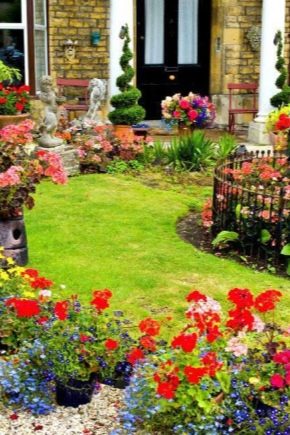
Land improvement includes the construction of a house, a utility zone, a garden or a park, and landscape decoration. The decoration of the site involves the design of flower beds.
To create a spectacular composition, you need to know the basic rules for organizing a flower garden, which are used by landscape designers. Let's try to figure out how to choose the optimal shape of the flower bed for the site, which plants to prefer, where it is better to arrange a flower garden.

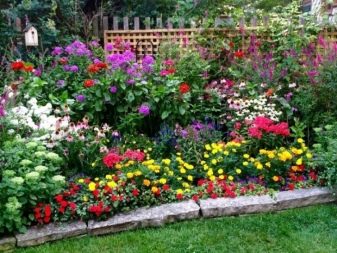
What it is?
A flower garden is a special piece of land where ornamental plants are planted in a certain combination. Ornamental plants include flowers, grasses, cereals, conifers and deciduous shrubs. Sometimes trees are also part of such compositions, if they are included in the visual range of a flower garden.
The selection of plants is carried out according to the principle of a harmonious combination of the color of foliage and inflorescences, the correspondence of the external structure of the ground part of the branches, stems, the shape of the crown of various specimens to each other.
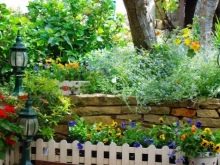
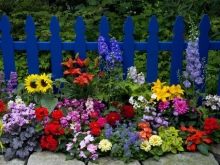
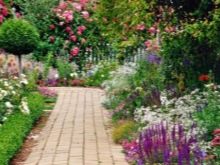
The flowering time, requirements for the composition of the soil, shade tolerance, winter hardiness and irrigation regime are taken into account, nearby plants should have similar requirements for growing conditions. A single comfortable environment is created that provides the maximum decorative effect of the species.
The main task is to equip a flower bed with a constant decorative effect throughout the growing season.
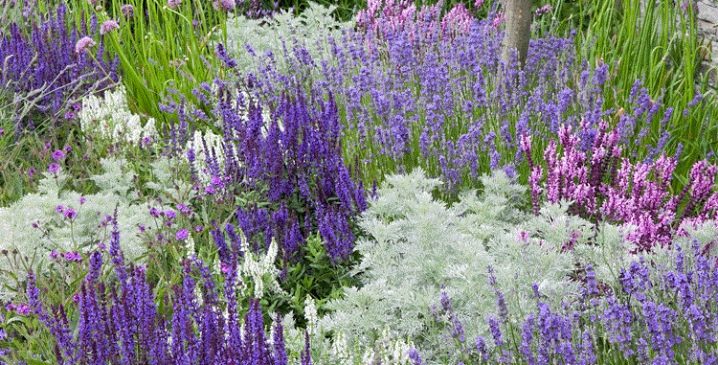
Plants are grouped in a variety of geometric shapes or are freely located on the site, while visually standing out against the general background, have clear borders in the form of a border, or are part of the landscape. The placement of flowers can differ in height: be in the plane of the ground or be located on natural or artificial relief.
Knowledge of these features of the organization of a flower garden will help in the competent design of the space.
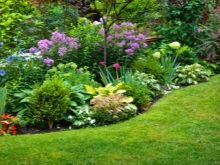
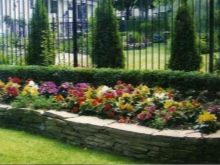
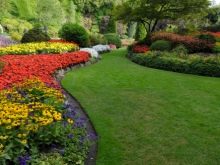
Peculiarities
Flower beds are formed in a regular or natural naturalistic style:
- Regular style symmetry, regular geometric shapes, axial structure of the composition are inherent.
- Natural style or the English uses the surrounding landscape to place a free-flowing flower garden.
In order to determine the style, the first thing you need to pay attention to is the functional purpose of the flower garden.
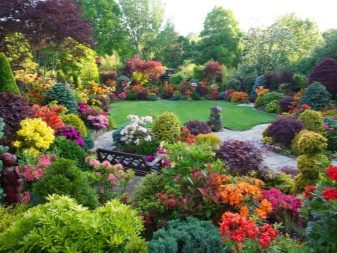

The flower garden in the front area of a private house is decorated with all sorts of splendor, the brightest specimens of plants are planted here, these ceremonial plantings are located in the entrance area, in front of the porch, along the path from the entrance gate to the entrance to the house and are the hallmark of the estate. The arrangement of these compositions is most often regular, they consist of repeating groups of identical plants, alternating with each other.
It can be in the form of a rectangle, circle or narrow strip along the path.

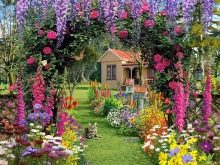
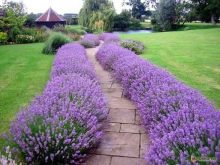
Plants are selected in accordance with the chosen style of the entire front area and the buildings located here. Roses, peonies, lilies, rhododendrons, clematis, hosts, and various conifers are chosen for classic-style mansions. For a summer cottage with a log house, an ethnic landscape design with perennial daisies, dahlias, Belgian aster, oak sage, phlox planted in chaotic but beautiful groups is more suitable.
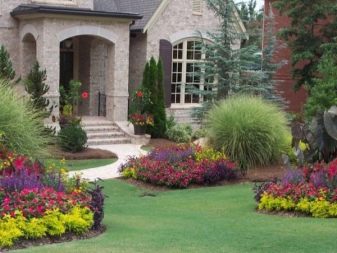
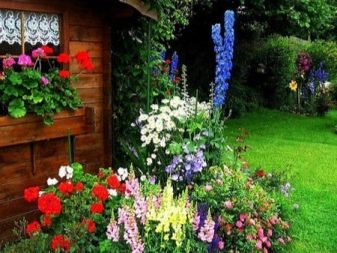
In the garden, flower beds that do not have a regular structure look better.Garden floristic compositions are designed to decorate the landscape of the area; here it is worth using relief or stones for arranging a flower bed.

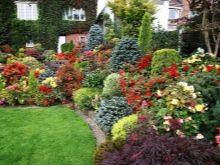

Trees or shrubs can be an accent here, around which suitable flowers and ornamental herbaceous plants will be located.
Natural flower beds are gaining more and more popularity, they consist of plants that grow in a given climate in nature. In the middle lane, these are wormwood, sage, catnip, mint, cereals, thyme, St. John's wort and other plants. Each species must be planted at least seven copies to create the desired color spot. Such compositions look very organic in gardens or park areas.
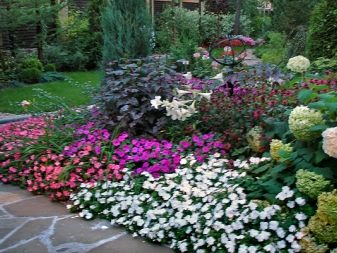

Flower beds can be collectible. One type of plant, but of different varieties, is planted in an array. The rosary is a vivid representative of such compositions. This type of flower garden can decorate both the front area, if it is decorated in a geometric shape, or be located in a free style among other green spaces. These mono flowers are distinguished by their sophistication and arouse constant interest among visitors.
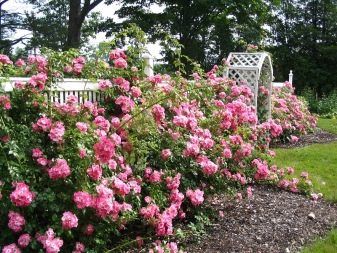

According to the growing conditions, sun and shade flower beds are distinguished. They differ in the composition of the plants. If sunny flower beds are more filled with flowering plants, then in shady compositions, herbaceous plants with beautiful foliage are used more - hosts, ferns, conifers. If in the first case the emphasis is on the beauty of the inflorescences, then in the second - on the play of the shape and color of greenery.
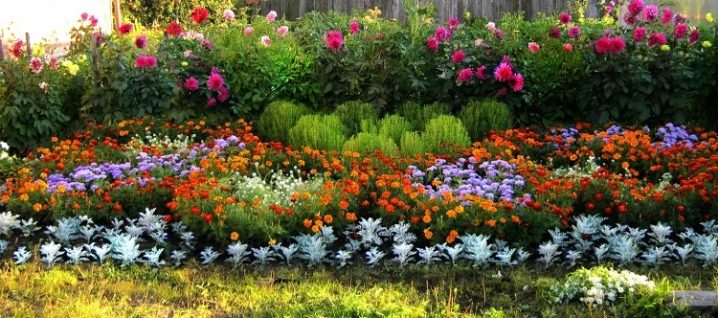
When choosing plants, attention is paid to frost resistance, whether a shelter is required for the winter, whether this shelter will spoil the type of flower garden. Wooden frames on plants in the front area do not look very nice in the autumn-winter period.
The irrigation regime and the composition of the soil in one flower bed are trying to withstand the same, the plants are selected with the same requirements for these conditions. Drought-resistant cereals will lose their decorative effect next to moisture-loving hosts.
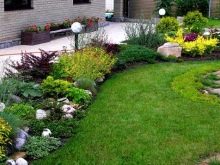
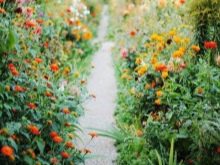
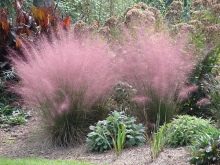
To decorate a flower garden, the harmony of color combinations is the most important condition, if you do not pay enough attention to this issue, you can get a multi-colored vinaigrette. It is worth familiarizing yourself with the color of all the inflorescences that you want to place in one flower bed in the reference books, imagine how they will look next to them, or use ready-made sets of plants that are offered by designers.
A flower garden with plants of the same color looks aesthetically pleasing, for example, white: saxifrage, dicenter, white iris, white bell, lily, white rose, peony, white chrysanthemum for autumn flowering. Such compositions are called monochrome.
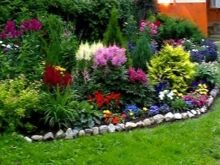
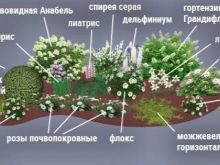
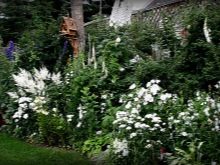
Flowers can be located not only horizontally, but also vertically. Beautifully flowering or ornamental-leaved vines are used to decorate garden fences or to install forged elements to support climbing roses or clematis. The designs, entwined with flowers, become the vertical accents of the garden.
A well-organized flower bed looks beautiful all season long, it is convenient to care for it and does not require frequent renewal of plantings.
Types and forms
For many decades of landscaping gardens and parks, a classification of types and forms of flower beds has developed.
Flower bed
The first place in landscape gardening design belongs to a flower bed that has the correct shape of a circle, oval, rectangle, triangle or rhombus.
This composition consists of symmetrically arranged plants with a pronounced center. To accentuate the central point, an artificial embankment is sometimes made, but more often the plants are planted according to their growth: high in the middle, low to the edges. The radial structure is emphasized with color.
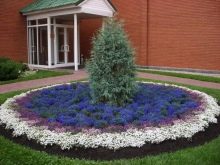
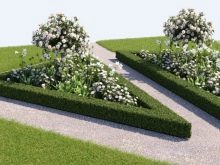
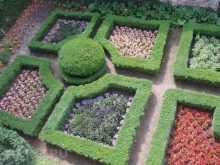
Traditionally, a flower bed is arranged in the front area so that it can be viewed from all sides, it is surrounded by paths or a lawn. The basis of the flower garden is made up of perennials, they are the frame and keep the shape of a garden figure in the autumn-winter period.Annuals fill the main space for the flowering period, the faded specimens are removed and replaced with the next flowering species that has a different flowering period.

Such a flower bed has clear boundaries that highlight the flower array against the background of the lawn. The border is arranged with the help of an extreme row of flowers, undersized trimmed conifers, a strip of mulched soil or a border. The borders here are made of natural stone, brick, metal, or a concrete border decorated with stucco molding is cast.
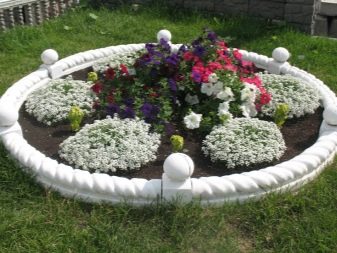

Parterre
Another group of ceremonial decoration of the site is the parterre. It is the oldest type of flower garden, consisting of a floral carpet pattern. The drawing consists of a patterned ornament using low, brightly blooming annuals. The pattern can be abstract, repetitive, or it can have a specific plot or depict a specific picture.
The size of the parterre varies from very small compositions to several hundred square meters of floral ornament.
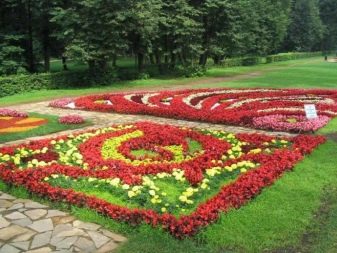
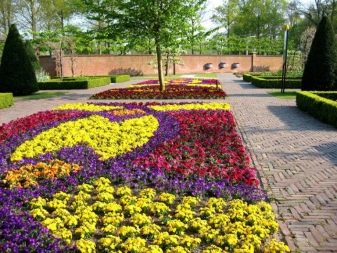
Rabatka
A narrow strip of ornamental plants - a rabatka - became a derivative of the parterre. It also has a symmetrical composition of the same elements. Its length is not limited, but its width should be proportionally narrow, to create the visual effect of elongation. The review should be equally good from all sides.
In fact, this is the same flower bed, only of an elongated shape. The rabatka is placed along the house, in the middle of the main alley, or on both sides of the path.
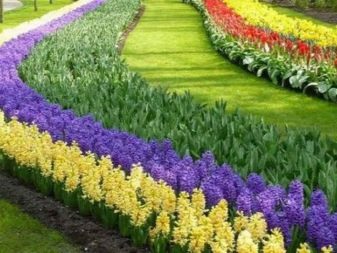
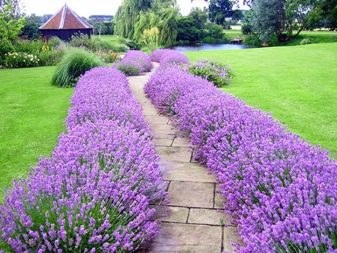
Modular
On the basis of the first two types, a variant of a modular flower garden has developed, where flower rosettes are interspersed with the covering material in a checkerboard pattern.
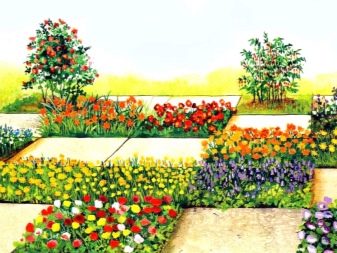
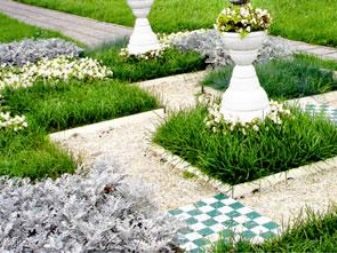
Mixborder
The growing popularity is gained by the flower garden organization scheme - mixborder. Its bulk is made up of perennial plants. The emphasis is on preserving decorativeness throughout the year. This led to the widespread use of evergreen conifers in mixborders. Flowers are complemented by plants with beautiful colors or unusual foliage shapes.
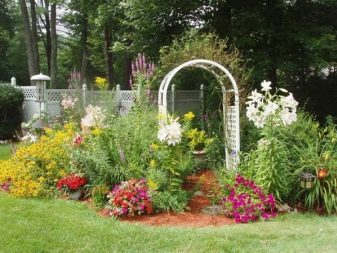
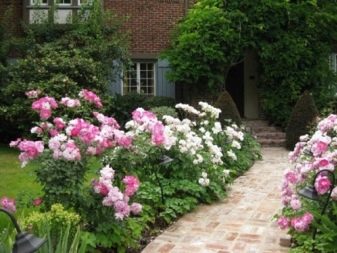
Attention is also paid to the habit and originality of the shape of the crown of shrubs. The decorative effect of cereals is used in all seasons. The name itself suggests an aesthetic mix of plants, which are arranged in tiers from high to low, like an amphitheater. For a better visual experience.
The size is limited in width, it should not exceed 1.5 times the height of the largest plant of such a flower garden. The length can be any. Usually placed along a fence or around a central lawn.
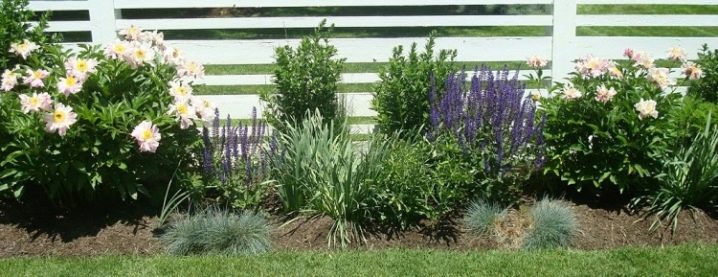
English
An English garden with natural flower beds is always in fashion. Flowers grow freely between trees or groups near the decor in the form of objects of peasant life, more often they create beautiful thickets near buildings and around stone retaining walls.
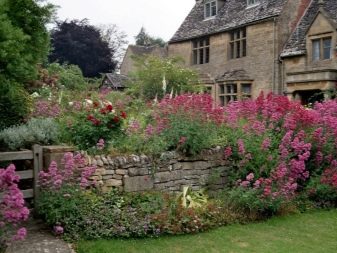
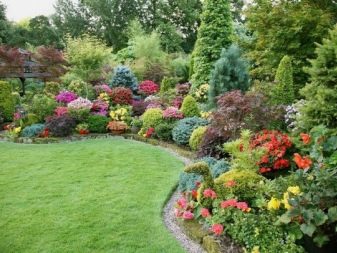
Rockery
The brutality of the stone is very beautifully combined with the tenderness of flowers and green needles. This was the basis for the emergence of rocky gardens. These flower beds highlight the stone component.
A multi-tiered relief slide is made of large stones, if necessary, they are fastened with a cement mixture. The pockets are filled with earth. Ornamental-leaved shrubs, ground cover plants, junipers, dwarf thuja are planted in them.
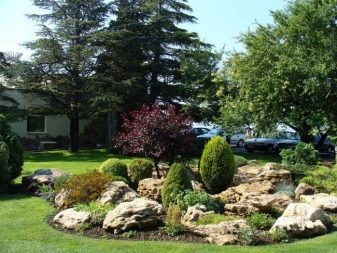
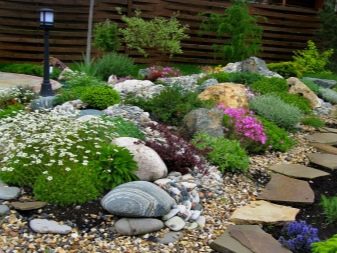
Alpine slide
A kind of rockery is an alpine slide, only its device is more complicated with the use of rocky rocks, the selection of an alpine mountain range of plants.
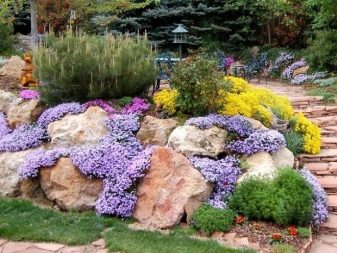
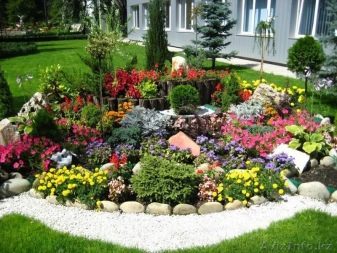
Tapeworm
Garden designers suggest artistically playing with some special plant against the background of a lawn or a monotonous wooden fence. Such a flower garden, consisting of one plant, with original features, is called a tapeworm. It can be a tree with a beautiful crown or clematis decorating the partition, or an unusual coniferous tree, or a giant cereal.
Still, the basis of any flower garden is made up of flowers and herbs, which one is better to give preference to?

Plants
Plants are divided into flowering and decorative foliage. The flowering plants are mainly used to create flower beds and for accents in mixed flower beds with coniferous and deciduous shrubs. The names of flowering plants can be listed endlessly.
Annual flowers have the greatest decorative effect, they allow you to decorate the site in one season, have a rich gamut of colors, vary in height and size of the rosette, allow you to diversify the color palette of the flower bed annually, do not need special feeding, bloom for a long time.

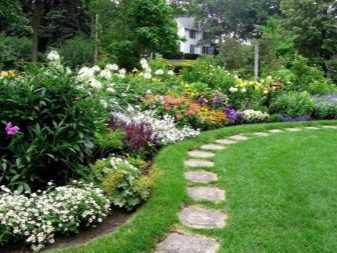
Popular among them are purslane, marigolds, petunia, lobelia, calceolaria, iberis, mallow, nasturtium and others. However, to lengthen the flowering season, they are all grown through seedlings, which creates additional hassle for the gardener.
Many people prefer perennial plants, they can develop and bloom for several seasons and require only weeding and feeding. Their flowers are more spectacular, these are roses, peonies, lilies, clematis, hydrangeas. They invariably inspire admiration for their sophistication and aroma. These luxurious flowers go well with thujas, junipers, cypress trees.
Conifers began to be actively used to decorate plots in central Russia not so long ago, but they have already won the love of gardeners for the variety and beauty of needles: from silver in fir trees to bright yellow in some varieties of thuja.
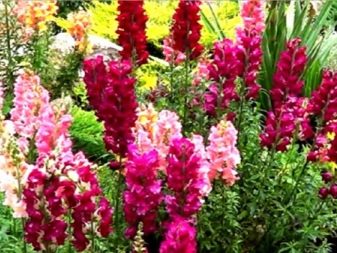
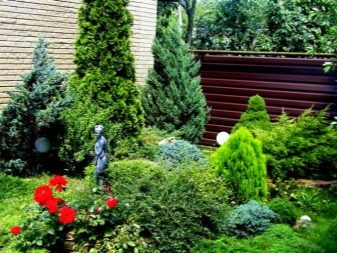
More and more cereals are becoming fashionable. They create a beautiful picture covered with fluffy ears of various colors: gray, yellow, burgundy and green.
Different types of plants are combined to create beds of continuous flowering. Bulbous plants are planted for the spring period: crocuses, tulips, daffodils, hyacinths. In the summer, the annuals delight with their beauty.
Perennial plantations from summer flowering pass to autumn colors of chrysanthemums, gladioli, dahlias. Roses have a very long growing season and bloom before frost. Cereals and conifers create the frame of the flower garden in the cold season.
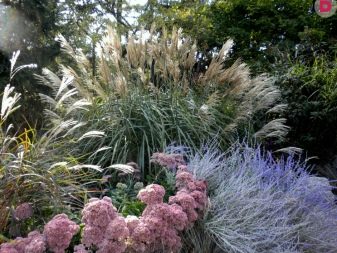

To increase the decorative effect, you can plant indoor flowers of tropical origin. Perennials by nature, they are used as annuals because of the brightness of the colors and the long flowering period. These are begonias and streptocarpus.
However, they must be grown in advance in indoor conditions in pots, and if desired, the specimens must be preserved, transplanted into pots again in the fall and transferred to the house. Another option: place flowerpots with these plants in the garden for the summer, and bring them indoors for the winter.
If the territory of the dacha is small and there is a need to grow vegetables, then you can arrange a decorative garden: with the right approach, it will look like a flower bed, decorate the site and be useful.
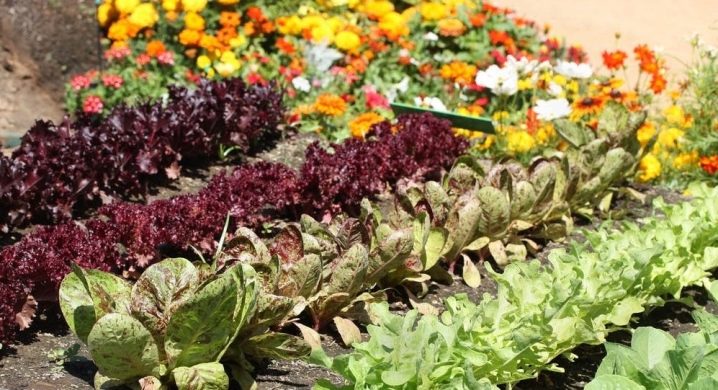
Planning
Main steps:
- Before you break a flower garden, you need to choose a place on the site.
- Determine the type of flower garden:
- It is better to arrange the path from the gate to the porch with a flower border or a rectangular rabat. It would be appropriate to equip a mixborder along the wall of the house or fence. It is good to decorate a long fence with vertical tapeworms of flowering shrubs or vines.
- In the courtyard of a mansion with a large plot of land, a classic flower bed or a lawn with a parterre will look spectacular.
- A small suburban area should be decorated in the English style with a free layout of flower beds.
- If there is relief or free space, you can give preference to rockeries or an alpine slide.
- After that, it is necessary to assess the illumination, soil composition and relief. Based on these conditions, take up the selection of colors. A planting scheme is drawn up, taking into account the size of an adult specimen.
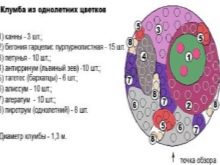
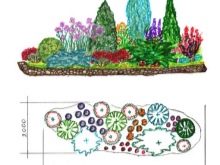

Landing
Priority of actions:
- At the first stage, the flower garden is marked, the outline of the flower bed is outlined on the ground. If necessary, a trench is dug to install the curb. The bottom of the trench is strengthened and a fence is mounted.
- The next step involves working with the soil. If the soil matches the selected plants, then the earth is simply dug up. To replace the soil, the top layer is removed, drainage is arranged and filled with the desired soil mixture.
- The third stage is the direct planting of plants, here you need to act according to the scheme. Can be confused by the presence of empty spaces left for the development of flowers and shrubs. Do not succumb to the temptation and compact plantings, closely planted plants begin to compete for food and illumination, and their decorative effect is reduced.

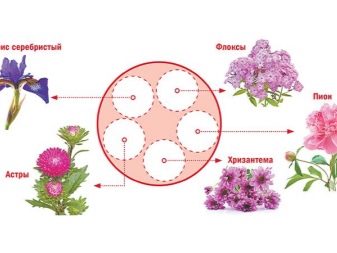
- When organizing a flower garden in a rustic style, a front garden is arranged in front of the house. Here it is better to choose flowers that are characteristic of this climatic zone and are traditional in the culture of the population of this area. The role of the curb is usually performed by a low fence; soil replacement is not required, since the zoned flora is used.
- Vertical accents in the form of vines are planted along the fence or a hedge is made. Conifers or shrubs of temperate latitudes are planted in a compacted pattern. The lower part is decorated with decorative flowers planted in the form of a border.
- For busy people, it is worth stopping at a flowerbed entirely consisting of perennials. Another name for such a flower bed is for the lazy. Although this name does not reflect reality: weeding, feeding, watering takes time and effort.
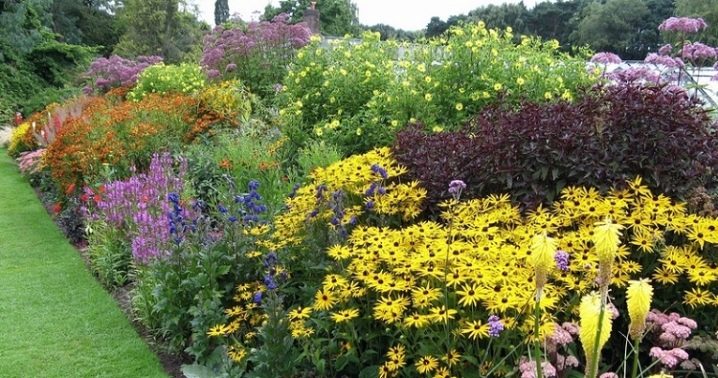
When using perennial plantings, you can avoid the annual spring planting of plants. Having bothered once, you can not transplant plants in a perennial flower bed for five to six years.
For such a flower garden, it is best to equip a mixborder, rockery or alpine slide. The composition of the same conifers of different types looks very impressive.
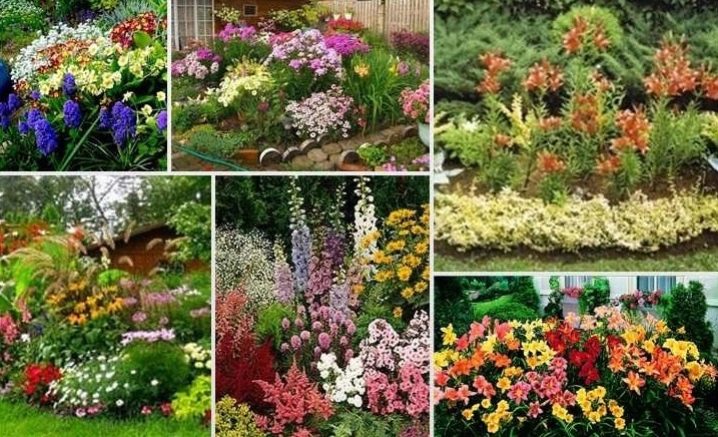
Useful Tips
When organizing a flower garden, it is better to use the following recommendations.
- When choosing a flower garden design, you need to take into account the surrounding landscape and the style of buildings on the site. The set of flowers for a plot in a pine forest will differ from a set for a yard in an apple orchard. In the first case, hybrid tea roses, rhododendrons, hyacinths, cannes, clematis will look harmonious. In the second, phlox, chamomile, mock-orange, rosehip will become decoration. Polyanthus roses or floribunda roses lined with wormwood or catnip look great in a natural garden.
- A parterre flower bed with a fountain or a curb made of wrought iron elements will not look next to a log house. The border for the flower bed should be combined with the material of the paths and the contents of the flower garden. If natural stone or brick was used for the paths, then it is better to make the curb from these materials or from metal.

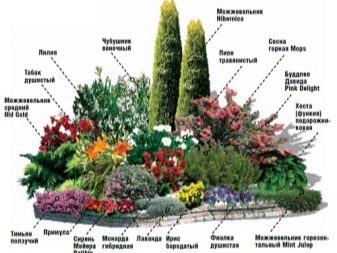
- Paths made of wood cuts will be beautifully complemented by a framing of a hemp flower garden.
- Dirt paths or a lawn can be separated from the flower bed by a border of flowers or a strip of gravel.
- For vertical accents of the rose garden, it is worth using zoned climbing roses on the supports. Modern covering materials make it easy to preserve roses in winter.
- An effective technique for decorating a flower garden is the use of lighting. Low light fixtures can be connected to electricity, but solar panels are more convenient. The cereal composition takes on a fantastic look thanks to the illumination.

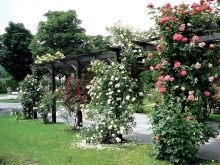
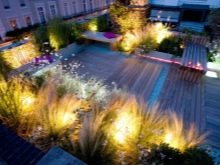
Beautiful examples and options
Landscaping is subject to the main artistic and architectural trends. The design style of the house and the plot determines the details of the flower beds. Modern minimalism makes the border part of the artistic composition along with the plants.
Very much decorates a flower bed with a pond or a stream. Moisture-loving flowers, willows and large hosta leaves create a frame for the water surface. The rustic style of the flower garden looks harmoniously with elements of a peasant setting and symbols of rural life.
A delightful parterre flower garden in front of a small house transforms an ordinary courtyard into a work of art.
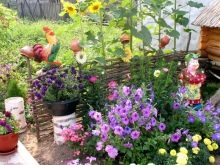
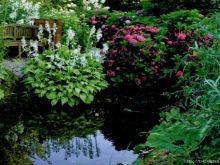
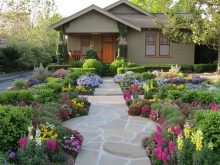
A portable flower garden can decorate any abandoned and unsightly corner of the yard.
In front of the windows in the northern part of the house, it would be a good solution to equip a decorative leaf mixborder. Preference should be given to conifers, ferns, hosts, astilbe.
In the shade of trees, geykhera, begonias, buzulniks, rogers, swimsuit, red-brown geranium, geyherella, badan feel great. Their leaves are distinguished by sophistication of forms and originality of bright colors.
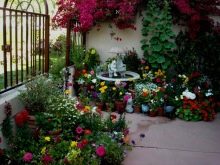

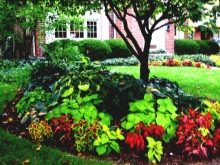
In this video you will find a practical guide on how to set up a flower garden near your home.







































































































The comment was sent successfully.